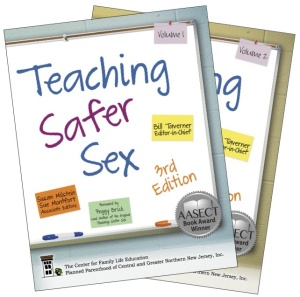 This week it’s all about Teaching Safer Sex!
This week it’s all about Teaching Safer Sex!
Did you know that TSS was the recipient of the AASECT Book Award?
Yep. It’s pretty great!
All of the Teaching Safer Sex lessons were recently uploaded to the Sex Ed Network, so if you become a Network member you’ll have immediate access to this and hundreds of other lessons from the CSE manuals that I’ve been blogging about!
I’m going to be blogging about the communication section in TSS this week. Here’s the first lesson plan from Volume 1, Section 4:
SAY WHAT?!?
Communicating About Safer Sex
By Allyson Sandak
Objectives
By the end of this lesson, participants will be able to:
- Demonstrate an understanding of passive, aggressive and assertive communication styles.
- Increase their comfort in talking about safer sex with a partner.
- Practice negotiating skills for safer sex.
Rationale
Young people often receive factual information about the proper use of safer sex methods such as condoms, female condoms and dental dams. However, skills development is necessary to negotiate using such safer sex methods. Knowledge of safer sex methods does not automatically transfer to behavior — knowing how a condom works does not necessarily mean that one will use a condom and/or feel comfortable discussing condom use with a sexual partner. Skills development and self-efficacy (the belief that one is capable to put those skills into practice) are key components to social learning theory, which informs much of current comprehensive sexuality education. Research indicates that pregnancy and sexually transmitted infection prevention programs that include skills development, including condom negotiation skills, have strong impact on teenagers’ intention to use condoms. Additionally, participants indicate that they need more information about negotiation and communication skills. This lesson will provide participants with an opportunity to develop comfort and skills around communicating assertively about safer sex.
Understanding the dynamics around passive, aggressive, and assertive communication styles is critical for students to deepen their skill set in effectively communicating with their partners and in making sure their partners are effectively communicating with them.
I recently led a lesson on these topics where I passively asked a student for something, aggressively asked another student for something, and then assertively asked a third student for something. The emotional reactions on the part of the students was remarkable – and they dissected it for some time afterwards.
The handout that describes these three kinds of communication in this lesson plan is top notch. It includes a general description, an example, and what someone’s speech, voice, eyes, and posture might look like. I would have loved to use this to help my students further deepen their understanding of communication styles in my recent lesson plan – and now I’m looking forward to using it in the future!




